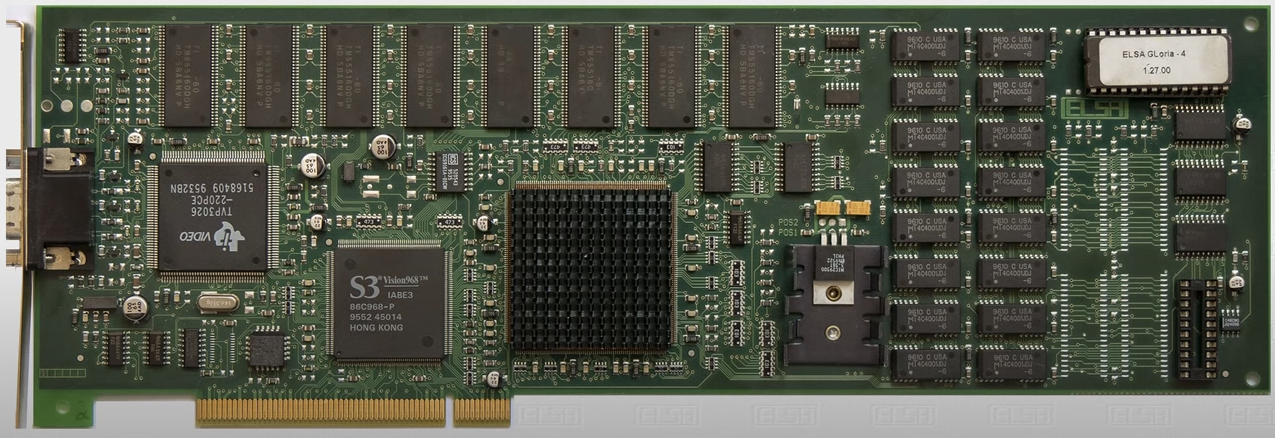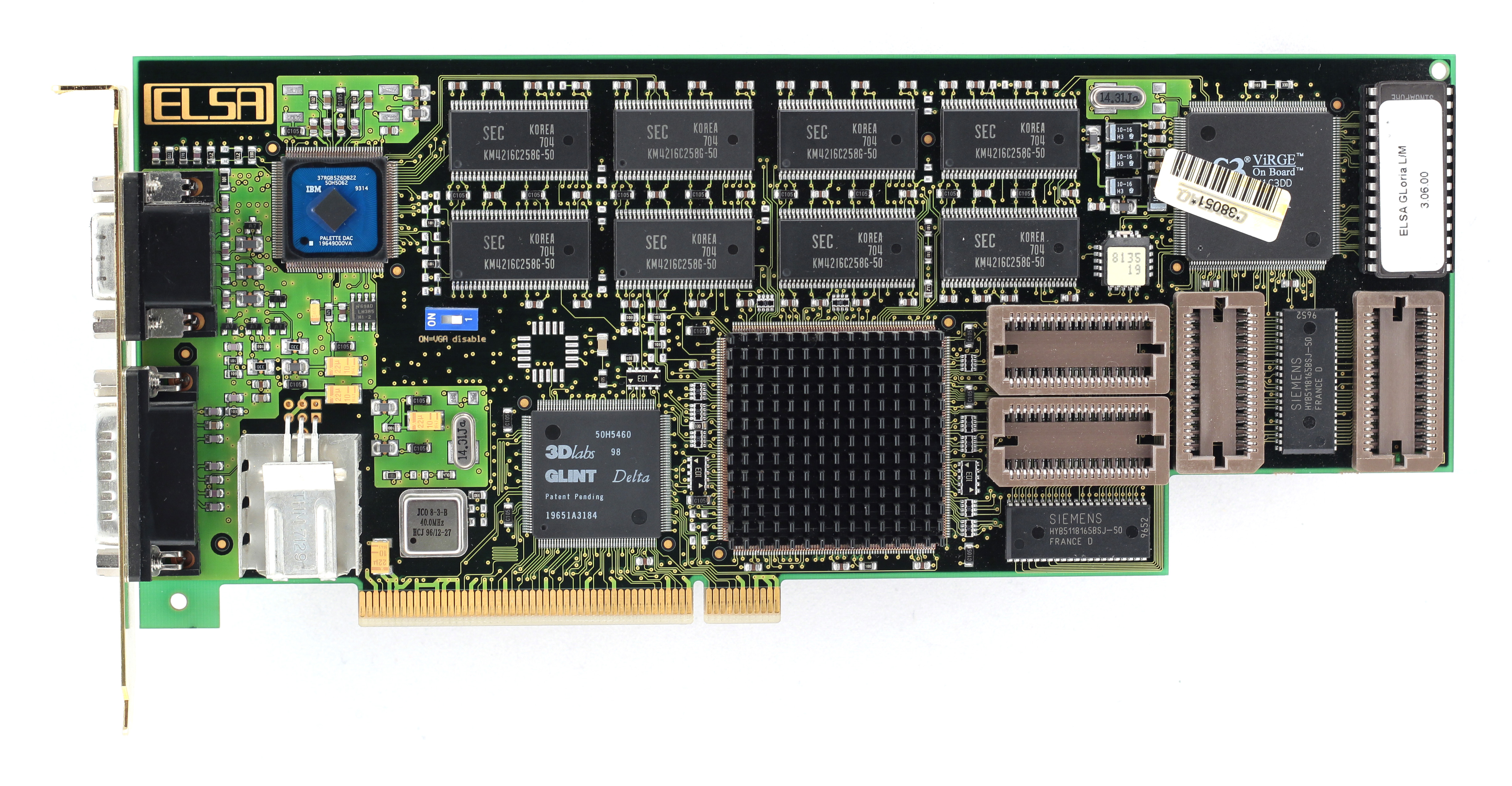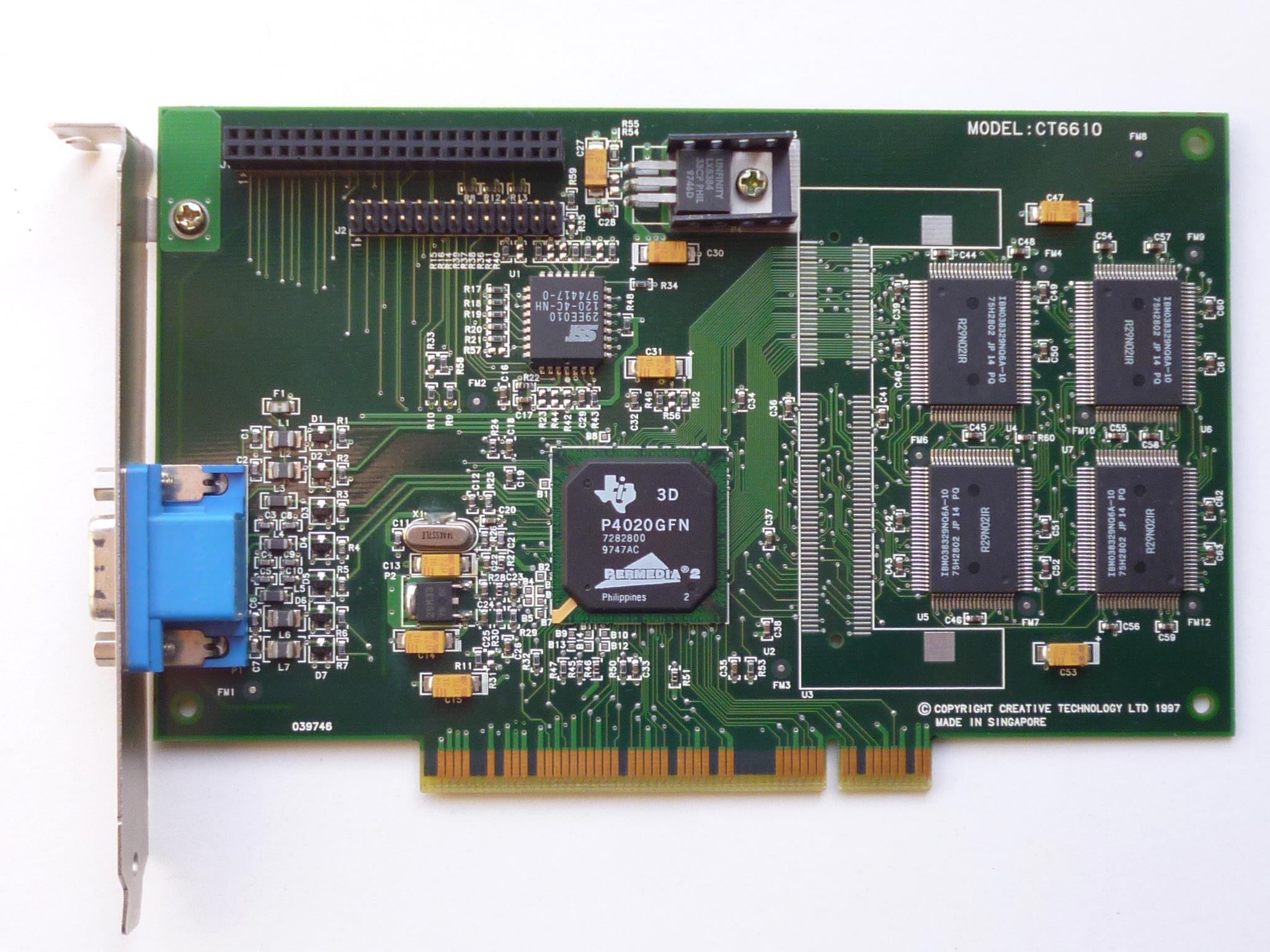 3D Labs, Inc. / 3Dlabs
3D Labs, Inc. / 3Dlabs
Originally formed back in 1983 as benchMark Technology, the San Jose, CA-based company was bought by DuPont and renamed to DuPont Pixel in 1988. After a management buyout in 1994, we have the 3dlabs company as we remember it from a DOS and Windows-era graphics card perspective.
They were most famous for their Permedia range of graphics accelerator chipsets that were designed for professional application use, not games, though in 1993 they had created probably the first 3D graphics accelerator with their GLINT 300SX 3D processor..
Not having their own chip fabrication factory, they relied of partnerships to get their chips to market, including Texas Instruments, ST Microelectronics and SGS Thomson.
The team of engineers and designers at 3Dlabs were pretty much the creators of the OpenGL 2.0 standard.
In 2002, they were acquired by Creative Labs. Soon after, the 3Dlabs arm of Creative was refocused solely on the professional graphics market, having recognised their inability to compete in the aggressive 3D gaming hardware market. In August 2006, Intel acquired the majority of the ex-3Dlabs graphic team, after an earlier announcement in February 2006 from 3Dlabs that the team were being redirected on technology for the mobile and handheld market.
 GLINT 300SX GLINT 300SX
Launched: 1993
Bus: PCI
A year before the management buyout from DuPont, the company launched their 3D graphics processor, GLINT 300SX, which was designed for professional use.
This was used on the ELSA GLoria (see image above) and Diamond FireGL with capabilities including Gouraud shading, flat shading, anti-aliasing, stencilling, fogging, alpha blending, clipping, texture mapping and more. The ELSA card also comprised S3's Vision968 for 2D graphics acceleration, 4 MB or 8 MB of video memory, and built-in compatibility with DirectDraw and OpenGL. |
 GameGLINT GameGLINT
Launched: 1994
Bus: VESA Local Bus
In order to penetrate the early 3D gaming market, 3Dlabs produced GameGLINT. One of the adopters of this chip was Creative Labs, who called their card 3D Blaster VLB (since it made use of the VESA Local Bus along with fast 486 CPUs). GameGLINT was a huge failure in the market. In all, only 13 games titles provided support for the GameGLINT, and it was soon superceded by faster PCI based cards used on better-performing Pentium PCs. |
 GLINT 500TX / GLINT Delta GLINT 500TX / GLINT Delta
Launched: 1995
Bus: PCI
3Dlabs went back to the drawing board and in 1995 released the successor to their GLINT 300SX, called GLINT 500TX. This was much faster at 3D operations and fully supported OpenGL, AutoDesk's HEIDI and Direct3D standards.
Once again, ELSA took on implementing several cards that had this new chip at their hearts: GLoria-M (4 MB VRAM + 4 MB EDO RAM, upgradable to 8 MB EDO RAM) and GLoria-L (8 MB VRAM + 8 MB EDO RAM, upgradable to 16 MB EDO RAM). GLoria-M still used the earlier GLINT 300SX processor while GLoria-L used the new 500TX, but the latter also got a 3D coprocessor called GLINT Delta. Both cards got an S3 ViRGE VGA chip with 1 MB of DRAM, and they ran with a pixel clock of 220 MHz. |
 Permedia / Permedia 1000 Permedia / Permedia 1000
Launched: August 1996
Memory: ?
Price: Under $200 for a typical 3D accelerator card
3Dlabs formed a partnership with Texas Instruments in May this year to fabricate their new Permedia chip - this was branded P4010GFN. Permedia was adopted quickly by Acer, ELSA, Symmetric, and NeTpower. In January 1996 Creative Labs licenced the Permedia technology to be able to create their own chips with an embedded Permedia core. The Permedia chip was complemented by a Texas Instruments TVP3026 RAMDAC.
It was claimed to generate 30 million texture-mapped pixels-per-second with high quality, true per-pixel perspective correction and full bilinear filtering, as well as 600,000 50-pixel triangles-per-second.
At the time of launch, Permedia was heralded for its fast performance in August 1996:
"Permedia has exceeded even own own aggressive expectations and is delivering outstanding Direct3D performance for all kinds of applications and titles under Windows 95." Neil Trevett, VP of Marketing, 3Dlabs.
"Permedia is an ideal accelerator for Direct 3D, and for accelerating the wide range of applications using Microsoft's DirectX APIs. Microsoft welcomes 3Dlabs applying their expertise to making Windows a compelling 3D platform. Permedia delivers high-performance Direct3D acceleration in a package that will make it accessible to a wide range of end-users." Kate Seekings, 3D technology evangelist, Microsoft
"Innovative second-generation processors like Permedia are what we need to make the dream of real-time immersive 3D gameplay a reality. 3Dlabs has done the right thing and invested heavily in its Direct3D drivers, letting us harness the power of Permedia through a standard API. Title portability, through the use of standard APIs is a vital step to making the 3D games market, and we applaud 3Dlabs in recognizing and encouraging the trend." Richard Leinfellner, VP of Research & Development, Mindscape.
Initially, only OpenGL drivers were available, along with professional application drivers.
Cards that used the Permedia include:
An enhanced version of Permedia was created, dubbed "Permedia NT". These enhanced PCI cards got the same Permedia chip but added a GLINT Delta 3D geometry chip and 8 MB of RAM. |
 Permedia 2 Permedia 2
Launched: May 1997
Bus: PCI and AGP 1x
Memory: 4 MB or 8 MB SGRAM (80-83 MHz typically)
The Permedia 2 was marketed as a card for professional use rather than 3D gaming, but it was quite unique in that it could also hold its own [to a point] with games too. It was a much faster chip than its forebear, Permedia. It provided support for both OpenGL and Direct3D, MPEG2 hardware acceleration and onboard DMA engine. One odd omission is its lack of VESA support.
Texas Instruments partnered with 3D Labs to fabricate the Permedia 2 under their codename of TVP4020. ST Microelectronics were also an authorised fabricator.
In late 1997, a die-shrunk version of Permedia 2, called Permedia 2V, allowed a small boost in performance with the same core/memory clocks, but RAMDAC now ran at 250 MHz.
"3Dlabs® Inc. today announced PERMEDIA® 2 the second generation of its low-cost graphics processor family targeted at the commercial desktop, entry-level professional and power consumer markets. PERMEDIA 2 is a highly-integrated graphics processor that accelerates 2D and 3D graphics, 3D geometry setup processing and MPEG-2 video playback.
PERMEDIA 2 increases performance by up to two times over the first-generation PERMEDIA while significantly reducing system cost through higher integration. PERMEDIA 2 incorporates a full floating-point geometry setup processor, based on proven GLINT® Delta technology, a high-performance 230MHz RAMDAC and an enhanced graphics engine with unified 2D, 3D and video acceleration. PERMEDIA 2 is fully-compatible with both PCI and AGP busses.
PERMEDIA 2 provides leading graphics performance. Some measured figures using beta drivers include: 110 Business Graphics Winmarks under Windows NT 4.0 at 1024x768x16 bits, one million texture-mapped 3D polygons-per-second and 80 million texture-mapped pixels-per-second with full perspective correction, bilinear-filtering and fogging enabled. Using the Ziff-Davis 3D Winbench benchmark, PERMEDIA 2 exceeded any currently published figures for integrated 2D/3D devices with a score of 131.
PERMEDIA 2 provides a compelling graphics solution for the commercial desktop by integrating high-performance 3D with no-compromise 2D in a low-cost package that exploits 3Dlabs' extensive range of software drivers. PERMEDIA 2 is also unique among low-cost graphics chips in being designed for OpenGL® performance and being able to run 3Dlabs' full OpenGL Installable Client Driver making it an ideal entry-level graphics solution for the personal workstation market.
PERMEDIA 2 has been developed under the technology licensing relationship between Texas Instruments and 3Dlabs. 3Dlabs and Texas Instruments will be co-marketing PERMEDIA 2 devices.
PERMEDIA 2 directly accelerates 3Dlabs' extensive range of software drivers that have been developed for the GLINT and PERMEDIA chip families, enabling OEMs to offer wide range of price/performance options while supporting just a single set of drivers. These robust and highly optimized drivers include an OpenGL Installable Client Driver and Autodesk's Heidi for Windows® NT 4.0 and Windows 95 and Direct3D for Windows 95. 3Dlabs has currently invested over 70 work years in its OpenGL Installable Client Driver, alone. Windows NT 5.0 and Memphis drivers are also being developed. This extensive set of APIs is expected to allow PERMEDIA 2-based boards to provide robust acceleration for almost all 3D applications ranging from high-end CAD packages such as SolidWorks to Direct3D game titles.
" 3Dlabs, 27 May 1997
Permedia 2 was 3Dlabs' last card to support Windows 95.
Cards that used the Permedia 2 include:
Performance of Permedia 2 cards is similar to Matrox G100, and a bit behind nVidia RIVA 128.
|
 Permedia 3 / GLINT R3 Permedia 3 / GLINT R3
Launched: June 1999
In late 1998, 3Dlabs started producing their own cards rather than just selling their 3D accelerator chips to third-party board manufacturers. After their first card, Oxygen GMX (an AGP card) which was targeted for the professional market only, they created the Permedia 3 Create! which was based on their brand new GLINT R3 chip. It was a 32 MB AGP card.
Permedia 3 was late to market, and upon launch was no longer competitive for 3D gaming, though as mentioned previously, all 3Dlabs chips were primarily designed for professional graphics applications such as CAD instead of 3D games. The 3D gaming market was awash by this point with competing companies including 3Dfx with their Voodoo cards.
Initially, only OpenGL drivers were available, along with professional application drivers.
|
 3D Labs, Inc. / 3Dlabs
3D Labs, Inc. / 3Dlabs




